#PLC Control Solutions
Explore tagged Tumblr posts
Text
Unlock the Power of Employee Automation Control Training
At BIN95, we understand the importance of equipping your team with the skills they need to excel in today's fast-paced world. That's why we offer an unbeatable deal - half off of our comprehensive training program and unlimited user and installation licenses.
Imagine the possibilities when every member of your organization (company or School) has access to cutting-edge training materials and resources. Our program covers everything from basic concepts to advanced techniques, ensuring that your team is well-equipped to handle any automation challenge that comes their way.
But time is running out! Don't let this opportunity slip through your fingers. Visit https://bin95.com/educational-site-licenses/ for more details and secure your purchase order today.
Invest in the future of your business or institution with Automation Control Training. Together, let's unlock a world of endless possibilities!
#automation control software#automation training#plc training#training solutions#tech school#STEM education#corporate training#community colleges#vocational training#plc#Motor Controls#hmi#vfd
2 notes
·
View notes
Text
Enhancing Textile Machinery Efficiency with Messung's NX-ERA Xpress PLC

The textile industry, being a part of global manufacturing, has witnessed a massive transformation in recent years due to accelerated technological advancements. From yarn making to dyeing yarns with complex patterns, each process of textile production has been streamlined for higher productivity, accuracy, and efficiency. The need for high-quality products and shorter production cycles has generated fertile ground for automation, especially with the use of Programmable Logic Controllers (PLCs)in textile manufacturing.
This is where we at Messung Industrial Automation come in the picture with our cutting-edge automation solutions. With our strong heritage of delivering strong and scalable automation solutions, we have been the industry leader in industrial automation. Our innovative and compact PLC, NX-ERA Xpress has been crafted to specifically address the specific requirements of industries such as textile manufacturingwith the ideal combination of performance, flexibility, and energy efficiency. In this blog, let’s explore the revolutionary potential of NX-ERA Xpress PLCand its impact on textile machinery, with an emphasis on how it improves operational efficiency, cuts costs, and accelerates the journey towards Industry 4.0.

The Role of PLCs in Modern Textile Manufacturing
Programmable Logic Controllers (PLCs) form the foundation of automation in textile manufacturing, especially in the "cotton to yarn" and "yarn to fabric" segments where their role is most critical. These rugged, industrial-grade controllers ensure precision, speed, and efficiency by managing machinery and processes in real time. From ginning and bale plucking to spinning, carding, drawframe, combing, ring frame machines, and autoconers, PLCs are deeply embedded in every stage of the cotton-to-yarn journey.
In the yarn-to-fabric sector, PLCs continue to play a significant role in the operation of warping machines, twisting machines, and various types of looms such as shuttle, airjet, and rapier looms. They are equally vital in fabric processing lines, managing singeing, bleaching, dyeing, and a wide range of finishing machines designed to enhance textile properties like softness, wrinkle resistance, or water repellency. Printing lines, including rotary and flat bed printing machines, also rely heavily on PLC-controlled automation.
Across these applications, PLCs are integrated with Human Machine Interfaces (HMI), Variable Frequency Drives (VFDs), and in high-speed machines like spinning lines, Servo amplifiers and Servo motors are used for superior speed and torque control.
While the garment sector (fabric to garment) does involve automation, Messung’s core expertise and solutions, including the NX-ERA Xpress PLC and NX-ERA Jet PLC, are primarily focused on the earlier and more automation-intensive stages of textile manufacturing.
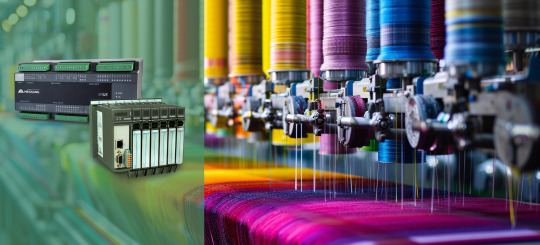
Benefits of Implementing PLCs on Textile Machinery
Increased Efficiency: PLCs allow streamline operations by automating processes that were previously manual, significantly reducing downtime and increasing throughput
Improved Accuracy: The high-level precision control afforded by PLCs ensures each activity in the fabric process, whether spinning or weaving, is undertaken with perfection.
Real-Time Monitoring: PLC-based systems make equipment monitoring in real-time a certainty, where defects are flagged off early and avoid costly downtime along with plant operation performance improvements.
As the textile industry advances, compact PLCs are not an indulgence but a must-have. Automation is the key to staying competitive, and industrial automation PLC systems like the NX-ERA Xpress are at the forefront of this revolution.
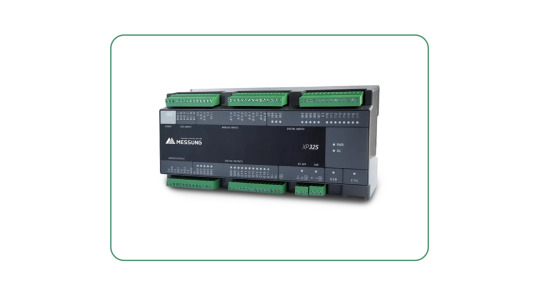
Learning More About NX-ERA Xpress PLC
The NX-ERA Xpress PLC is our response to the increasing needs of the textile industry. By harnessing the capability of Programmable Logic Control Systems and the flexibility of contemporary communication protocols, the NX-ERA Xpress provides a powerful and scalable solution for numerous industrial automation applications.
Features of NX-ERA Xpress PLC:
High-Density Digital and Analog I/O: The NX-ERA Xpress PLC features a high-density I/O design that is capable of processing vast amounts of data input and output at one time. This is important for the textile industry, where real-time data from many machines need to be processed efficiently in order to optimize performance.
Programming through Codesys® (IEC 61131 Standard): Among the most impressive aspects of the NX-ERA Xpress PLC is its support for Codesys®, an open-source programming platform. This standardization enables seamless integration with industrial equipment across the board, which makes it an attractive option for PLC manufacturing companies.
Integrated Communication Protocols: With inbuilt compatibility for communication protocols such as Ethernet TCP/IP, Modbus, and CANopen, the NX-ERA Xpress PLC facilitates smooth connectivity among various machines and devices on the shop floor. This connectivity is vital for ensuring smooth operation throughout the complete manufacturing process.
Industry 4.0 Readiness: NX-ERA Xpress PLC comes with OPC-UA and MQTT readiness, making it Industry 4.0-ready. These are technologies that support data exchange over different platforms, and they simplify the integration of machines by manufacturers into a smart factory environment.
Integrated HTML Web Server for Remote Monitoring: Remote monitoring has never been simpler. The integrated HTML web server enables operators to monitor and control the PLC remotely, offering flexibility and real-time visibility into machine performance.
The high-performance features and compact PLC design of NX-ERA Xpress PLC make it perfect for the textile industry. Whether you're automating cotton spinning, weaving, or dyeing, the NX-ERA Xpress provides all the power you need to optimize your operations.
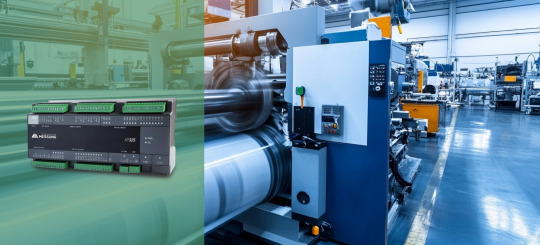
Advantages of NX-ERA Xpress in Textile Applications
The textile industry requires solutions that are capable of providing not just high performance but also cost-effectiveness and sustainability. Our NX-ERA Xpress PLC provides a number of benefits for applications in textile machinery, such as:
Energy Efficiency
In the textile industry, energy consumption is a major operational expense. The NX-ERA Xpress PLC is built to maximize control and minimize power consumption, especially in power-hungry processes such as spinning. Through automation processes and optimizing machine efficiency, the PLC ensures textile plants make substantial savings on energy.
High-Speed Processing
Textile production processes often involve rapid and adaptive control systems that are necessary for handling high-speed manufacturing lines. The processing of high speeds facilitated by the NX-ERA Xpress PLC helps data move faster to provide instant adjustment capabilities, ensuring minimum lags in manufacturing processes.
Precision Control
The clothing industry is based on the effective control of variables like thread tension, fabric alignment, and dying processes. NX-ERA Xpress PLC ensures accurate control in order to match every parameter in the manufacturing process to the prescribed specifications. The result is repetitive product quality, and less it is defective.
Scalability
As textile factories develop and expand, scalable automation systems become increasingly relevant. NX-ERA Xpress PLC uses a modular construction that means that automation systems can be expanded as they are required by manufacturers, presenting a great solution for expanding businesses in the textile industry in the long term.
Cost-Effectiveness
Automation must not be expensive. The NX-ERA Xpress PLC is an affordable solution for textile producers that offers high-end features without an exorbitant price tag. It is meant to offer high-performance at an affordable rate, so any textile firm can use it.

Textile Machinery Applications: PLC Precision for a Modern Mill
As textile factories embrace digital transformation, the NX-ERA Xpress PLC emerges as a compact yet powerful solution tailored for automation-ready textile machinery. With its robust control features and Industry 4.0 connectivity, the NX-ERA Xpress brings intelligence and agility to a wide range of textile processes.
Let’s explore key use cases across the textile value chain:
Yarn Steaming Machine:
Steaming is a critical stage in yarn preparation where temperature, pressure, and timing must work in harmony. The NX-ERA Xpress PLC ensures:
Precise control of temperature and steam pressure for consistent yarn conditioning
Regulation of steaming duration to match different yarn types and production speeds
Automation of loading and unloading mechanisms, reducing manual intervention and boosting throughput
With its real-time responsiveness and compact design, the NX-ERA Xpress PLC enhances efficiency, consistency, and reliability in yarn steaming operations.
Heat Setting and Space Dyeing Machine Integration:
In advanced textile finishing, seamless integration between heat setting and dyeing is essential. NX-ERA Xpress PLC brings synchronization and control to:
Temperature management for precise heat setting, improving dimensional stability and dye fixation
Control of dye application in the space dyeing process, enabling unique patterns with consistent results
Coordination of material flow between machines, ensuring smooth transitions and avoiding process bottlenecks
The result is an integrated, high-performance workflow for specialty dyeing applications, digitally governed for optimal output and reduced waste.
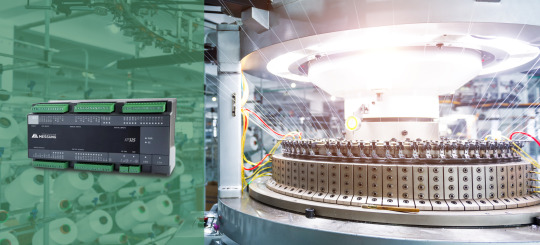
Integration with Messung's Automation Ecosystem
One of the major strengths of the NX-ERA Xpress PLC is that it can integrate smoothly with all our other products, like the XM-PRO remote I/O modules. This makes it possible to have a unified automation solution that simplifies the control and monitoring of your entire textile plant.
With a single provider for all automation needs, textile manufacturers can enjoy streamlined operations, reduced complexity, and improved support. The synergy between the NX-ERA Xpress PLC and our other products ensures that your factory is fully equipped to tackle the challenges of modern textile manufacturing.
Conclusion
In summary, our NX-ERA Xpress PLC is a game-changer in the textile sector, providing powerful, scalable, and affordable automation. With its high-performance capabilities, energy efficiency, and accurate control, the NX-ERA Xpress PLC is ideally positioned to address the changing needs of textile producers.
With the NX-ERA Xpress PLC, you can elevate your textile manufacturing process to the next level. Whether you want to optimize spinning, weaving, or dyeing processes, Messung's automation solutions provide the reliability and performance that you require to remain ahead in a competitive market.
So, why wait? Consult Messung today for a customized automation solutionthat suits your textile manufacturing needs. It’s time to embrace the future of textile production with the NX-ERA Xpress PLC - where automation meets innovation
#textile manufacturers#Programmable Logic Controllers (PLCs)#textile manufacturinG#cutting-edge automation solutions#compact PLC#NX-ERA Xpress PLC#textile machinery#Industry 4.0#spinning#carding#drawframe#combing#ring frame machines#autoconers#singeing#bleaching#dyeing#PLC-controlled automation.#NX-ERA Jet PLC#industrial automation#PLC systems#IEC 61131 Standard#Ethernet TCP/IP#Modbus#CANopen#cotton spinning#automation processes#remote I/O modules#automation needs#customized automation solution
0 notes
Text
Top Automation Engineers in Illinois | Innovating Industrial Solutions
Automation engineers are specialized professionals who design and implement systems that reduce human intervention in industrial processes. They blend knowledge from multiple fields—mechanical, electrical, software, and control engineering—to create intelligent systems that operate efficiently, reliably, and autonomously.
Their typical responsibilities include:
Designing automation systems from concept to installation
Programming PLCs (Programmable Logic Controllers) and HMIs (Human-Machine Interfaces)
Integrating robotics and motion control
Developing SCADA (Supervisory Control and Data Acquisition) systems
Testing and troubleshooting automated equipment
Ensuring safety and compliance with industrial standards
In Illinois, automation engineers are indispensable to manufacturing, logistics, food processing, energy, and life sciences.
Why Illinois Is a Powerhouse for Automation Engineering
Several key factors contribute to Illinois’s prominence in automation engineering:
1. Diverse Industrial Base: Illinois boasts industries ranging from automotive and agriculture to pharmaceuticals and aerospace. This diversity fuels consistent demand for custom automation solutions.
2. Strong Educational Ecosystem: Top-tier institutions like the University of Illinois, Northwestern University, and Southern Illinois University produce highly skilled engineers with expertise in robotics, AI, and industrial systems.
3. Strategic Location: Illinois's central location offers excellent logistics, making it a favored site for advanced manufacturing, warehousing, and distribution centers—all of which benefit from automation.
4. Innovation-Friendly Climate: The state supports innovation through tech incubators, grants, and public-private partnerships that empower engineers to develop and deploy cutting-edge automation solutions.
Key Services Offered by Automation Engineers in Illinois
Automation engineers in Illinois provide an extensive range of services tailored to the specific needs of businesses across the state. Common services include:
System Integration: Designing and installing complete automation solutions that synchronize machines, robots, and control systems.
PLC & HMI Programming: Writing and testing software that governs system behavior and interfaces.
Robotics Engineering: Installing and configuring robotic arms and automated material handling systems.
Industrial IoT Integration: Connecting machines to networks for real-time data exchange and monitoring.
Retrofitting & Upgrades: Enhancing legacy equipment with modern control technologies.
Safety System Design: Implementing fail-safes, emergency stops, and safety protocols in compliance with OSHA and ISO standards.
Whether working on a small assembly cell or a full-scale production line, Illinois automation engineers prioritize reliability, scalability, and efficiency.
Industries Benefiting from Automation Engineers in Illinois
The work of automation engineers touches nearly every corner of Illinois’s economy. Key sectors include:
Food and Beverage: Automating sorting, bottling, and packaging processes to ensure hygiene and speed.
Pharmaceuticals and Medical Devices: Ensuring precision, compliance, and traceability through automated filling, labeling, and inspection.
Automotive and Aerospace: Deploying robotic arms and motion systems for parts assembly and quality control.
Agriculture and Grain Processing: Integrating automation into storage, sorting, and packaging facilities.
Warehousing and Logistics: Developing conveyor systems, pick-and-place robots, and automated guided vehicles (AGVs).
Energy and Utilities: Implementing SCADA and remote control systems to manage plant operations.
By adopting automation, these industries reduce labor strain, improve accuracy, and increase throughput—critical in today’s competitive global marketplace.
The Future of Automation Engineering in Illinois
As we move further into the age of Industry 4.0, the role of automation engineers is evolving. Engineers in Illinois are not just builders of machines—they are architects of data-driven, intelligent systems. The future will include:
Edge Computing and AI: Allowing systems to make real-time decisions at the source.
Cloud-Connected Automation: Centralized data storage and analysis across multiple plants.
Predictive Maintenance: Using machine learning to anticipate equipment failures before they occur.
Digital Twins: Creating virtual replicas of physical systems for simulation and optimization.
Green Manufacturing: Designing systems that reduce energy use and support sustainability.
Illinois is well-positioned to remain at the forefront of this transformation, with a workforce ready to meet the challenges and opportunities ahead.
Choosing the Right Automation Engineer in Illinois
When selecting an automation engineer or firm, businesses should look for:
Experience Across Industries
Proficiency with Major Platforms (Allen-Bradley, Siemens, Beckhoff, etc.)
Commitment to Safety and Compliance
Strong Project Management and Communication Skills
Local Support and Maintenance Services
A collaborative approach ensures solutions that align with business goals, budget, and operational scale.
Your Automation Engineering Partner: Xtreme Automation LLC
If your Illinois-based business is ready to embrace the future of smart manufacturing, Xtreme Automation LLC is here to help. With decades of experience in automation design, PLC programming, robotics integration, and system retrofitting, Xtreme Automation provides comprehensive engineering solutions tailored to your industry. From planning and development to implementation and support, their team ensures your automation journey delivers real results. Learn more at xtremeautomationllc.com.
#Automation Engineers Illinois#Industrial Automation Services#Robotics Engineering Illinois#Control System Engineers IL#Automation Integration Companies#Smart Manufacturing Illinois#PLC and HMI Programming#Engineering Solutions Illinois#Industrial Robotics Experts#Factory Automation Consultants
0 notes
Text
Essential Components of Industrial Automation & Control Systems
Industrial automation and control systems rely on essential components to enhance efficiency, accuracy, and productivity. Programmable Logic Controllers (PLCs) manage operations with precision, while sensors and transducers collect real-time data. Human-Machine Interfaces (HMIs) enable seamless interaction, and motor drives control speed and movement. SCADA systems ensure remote monitoring, while industrial networking connects devices for smooth communication. Power supplies and circuit breakers safeguard equipment, preventing failures. Together, these components create a reliable automation ecosystem, optimizing production, reducing downtime, and improving safety across industries. Investing in high-quality automation components ensures long-term operational success.
#industrial automation#industrial equipment#industrial spare parts#industrial#automation#industrial and marine automation#industrial parts supplier#industrial innovation#automation solutions#Marine Automation#marine equipment#marine spare parts#auto2mation#Control systems#Industrial Control systems#Plc#sensor#motor#hmi
0 notes
Text
Can A Packaging Equipment Manufacturer Help With Automated Solutions?
Yes, a packaging equipment manufacturer can definitely help with automated solutions, enhancing efficiency, consistency, and productivity in packaging operations. As industries grow and demand increases, businesses are turning to packaging automation solutions to streamline their production lines, reduce labor costs, and improve product quality. Read More:- https://qr.ae/pY59Kb

#plc programming services#industrial automation in robotics#plc programmable controller#industrial automation solutions
0 notes
Text
Innovations in Integrated Transportation Technology
We now take for granted our capacity to travel short distances and long distances. Adversities have shaped the evolution of transportation, and some of them have resulted in amazing inventions—the wheel being the most well-known example. In order to adapt to the evolving requirements of humanity, modes of transportation have become more complicated and efficient over the ages. The development of transportation throughout history has brought us to this point, when we can travel around the globe in less than two days, across the channel by rail via underwater tunnels, and use spacecraft to see beyond the end of our solar system. Naturally, the human foot was the earliest mode of transportation, and that is where it all began for Integrated Transportation Solutions.

#Integrated Transportation Solutions#PLC & SCADA Automation in Qatar#Access Control System Qatar#Tolling System Qatar#Congestion Charging Qatar#Tunnel Maintenance Qatar
0 notes
Text
"The Crucial Role of Industrial Control Integrators: Driving Efficiency and Innovation in Modern Industry"
The Essential Role of an Industrial Control Integrator in Modern Industry
In today’s fast-paced industrial environment, the expertise of an Industrial Control Integrator has become indispensable. These professionals or companies specialize in designing, implementing, and maintaining complex control systems that are critical for optimizing industrial processes. This blog delves into the pivotal role of an Industrial Control Integrator, explaining their key responsibilities and the impact they have on industrial efficiency.
What is an Industrial Control Integrator?
An Industrial Control Integrator is a specialized expert or firm responsible for creating and managing control systems that automate and regulate industrial machinery and processes. These control systems encompass both hardware and software components, which work together to enhance performance, increase reliability, and streamline operations.
Core Responsibilities of an Industrial Control Integrator
Control System Design and Engineering:
Needs Analysis: The integrator begins with a comprehensive assessment of the client’s specific requirements. This involves understanding their industrial processes and defining the desired outcomes.
Custom System Design: Based on the assessment, the integrator designs a bespoke control system, selecting the appropriate sensors, controllers, and communication protocols to meet the client’s needs.
Integration and Installation:
Hardware Setup: The integrator manages the installation of essential components such as Programmable Logic Controllers (PLCs), Human-Machine Interfaces (HMIs), and other field instruments.
Software Configuration: They also configure the software that governs the control system, ensuring seamless communication between hardware and other operational systems.
Testing and Commissioning:
System Testing: Before full deployment, the integrator conducts rigorous testing to identify and rectify any issues, simulating real-world conditions to verify system performance.
Commissioning: Once testing is complete, the integrator supervises the final commissioning process, making any necessary adjustments to ensure optimal functionality.
Training and Ongoing Support:
Staff Training: Integrators provide training for the client’s personnel, equipping them with the knowledge to operate and maintain the new system effectively.
Continued Support: They offer ongoing maintenance and support services to resolve any issues and ensure the system continues to operate smoothly.
Why Industrial Control Integrators are Vital
Boosting Efficiency:
Industrial Control Integrators streamline processes by automating operations, which reduces manual input and enhances precision. This leads to improved productivity and reduced operational costs.
Enhancing Safety:
Integrators implement advanced control systems that monitor conditions in real time, increasing workplace safety by triggering alarms or shutdowns when necessary.
Ensuring Reliability:
By designing systems with redundancy and fail-safes, integrators help minimize downtime, which is crucial for meeting production targets and maintaining product quality.
Facilitating Scalability:
As businesses expand, their control systems must adapt. Integrators create flexible solutions that can be easily scaled or upgraded to meet growing demands.
Incorporating Emerging Technologies:
With the rise of Industry 4.0, integrating new technologies such as the Internet of Things (IoT), advanced analytics, and Artificial Intelligence (AI) is becoming increasingly important. Control integrators are key to incorporating these innovations into existing systems.
The Future of Industrial Control Integration
The field of industrial control integration is continuously evolving, driven by technological advancements and shifting industry needs. Future trends include:
AI and Machine Learning Integration: Enhancing predictive maintenance and process optimization.
IoT Integration: Enabling more detailed data collection and real-time analytics.
Enhanced Cybersecurity: Addressing the increasing need for robust security measures to protect industrial control systems from cyber threats.
Conclusion
Industrial Control Integrators are essential in ensuring the efficiency, reliability, and safety of modern industrial processes. Their expertise in designing, implementing, and maintaining control systems is crucial for optimizing operations and keeping pace with technological advancements. For businesses looking to upgrade or implement control systems, partnering with a skilled Industrial Control Integrator can be the key to achieving greater efficiency and performance.
#Industrial Control Integrator#Industrial Automation#Control Systems Engineering#Programmable Logic Controllers (PLCs)#Human-Machine Interfaces (HMIs)#Industrial Process Optimization#Automation Solutions#System Integration#Industrial Efficiency#Operational Reliability#Advanced Control Systems#Industry 4.0#Internet of Things (IoT)#Artificial Intelligence (AI) in Industry#Predictive Maintenance#Industrial Cybersecurity#Control System Design#Industrial Technology Trends#Engineering and Integration Services#Manufacturing Automation
0 notes
Text
Revolutionizing Industry Standards: Automation Solutions in New Zealand
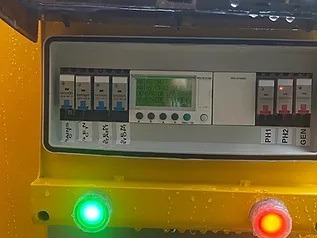
Renegade Electrics pioneers cutting-edge solutions tailored to New Zealand's industries. Explore our expertise in Pump Control Panel designs, Generator Automation, PLC Controller Programming, and Low-cost PLC controllers.
#Generator Automation in new zealand#Generator automation specialists in new zealand#PLC generic generator automation in new zealand#generator automation program in New Zealand#electric automation in new zealand#electric automation service in new zealand#electric automation solutions in new zealand#automation electric controls in new zealand
0 notes
Text
Replacing Discontinued S7-300 with an ARM Based EdgeCOM

Siemens confirms that the SIMATIC S7-300 product families will be available until October 1st, 2023.
Some distributors will stock inventory of relevant spare parts in advance, for users, it seems that they don't have to worry about purchasing the product in the short term, but in the future, they will need to pay a high price to purchase it. So users who have been using S7-300 better replace it in advance.
BLIIoT BL30x series of ARM Based EdgeCOM is an excellent choice for you.
Advantage of ARM Based EdgeCOM
Siemens confirms that the SIMATIC S7-300 product families will be available until October 1st, 2023.
Some distributors will stock inventory of relevant spare parts in advance, for users, it seems that they don't have to worry about purchasing the product in the short term, but in the future, they will need to pay a high price to purchase it. So users who have been using S7-300 better replace it in advance.
BLIIoT BL30x series of ARM Based EdgeCOM is an excellent choice for you.
High Performance
BL304 EdgeCOM is built around NXP i.MX8M based on Arm Cortex-A53 and Cortex-M4 cores, enables high performance and stability.
Programmable
The EdgeCOM supports Linux, Ubuntu, Debian; Node-Red, QT, Python, C++; MySQL, InfluxDB, SQLite, Docker, Ignition, these facilitate customer development.
Direct connection to HMI
BLIIoT BL304 ARM Based EdgeCOM can be connected to HMI directly, so data can be viewed via HMI.
Comes with Ethernet Ports
BLIIoT BL304 ARM Based EdgeCOM comes with two Ethernet ports to make programming and debugging more convenient.
Small Form Factor
BLIIoT BL304 is a tiny ARM Based Computer which can be easily installed inside the machinery, making it an ideal control device for industrial solutions.
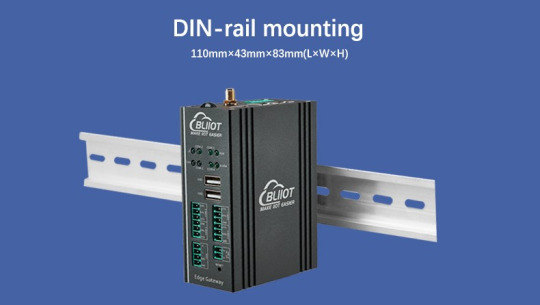
View More
0 notes
Text
How Switchgears Contribute to Power Quality and Equipment Longevity
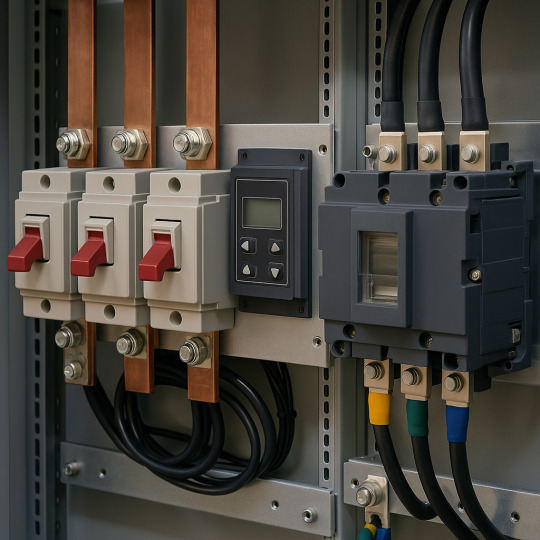
In today’s industrial landscape, facility uptime, energy efficiency, and equipment lifespan are directly tied to power quality. Poor power quality doesn’t just inflate energy costs — it silently wears down critical machinery, causes unexpected shutdowns, and leads to costly repairs. One often overlooked hero in this equation is the switchgear. Modern switchgears do far more than just control and protect power circuits; they actively safeguard power quality and extend the life of your equipment.
In this article, we’ll explore the vital role switchgears play in maintaining power quality and ensuring long-term reliability in industrial and commercial facilities.
Understanding Power Quality: Why It Matters
Power quality refers to the stability, reliability, and cleanliness of the electrical power supplied to equipment. Factors that degrade power quality include:
· Voltage sags and swells
· Harmonic distortion
· Transient surges
· Frequency variations
· Imbalance between phases
When power quality is compromised, sensitive equipment like drives, motors, PLCs, and even lighting systems can suffer reduced lifespan, malfunction, or complete failure. High-quality power is not a luxury; it’s a necessity for operational efficiency and safety.
Switchgears: The Gatekeepers of Power Integrity
Switchgears serve as the nerve center of power distribution in any facility. Here’s how modern switchgear solutions help maintain and enhance power quality:
1. Voltage Regulation and Stabilization
Advanced switchgears monitor voltage levels in real time and protect equipment from harmful sags or swells. Features like automatic voltage regulation and voltage balancing ensure your sensitive loads receive stable power, preventing stress on motors and electronic devices.
2. Harmonic Filtering
Some modern switchgear systems come integrated with harmonic filters or support external filtering solutions. Harmonics generated by variable frequency drives (VFDs), UPS systems, and other non-linear loads can cause overheating and inefficiencies. Switchgears mitigate these distortions, protecting downstream equipment and improving overall energy efficiency.
3. Surge and Transient Protection
Switchgears equipped with surge protection devices (SPDs) act as the first line of defense against voltage spikes and transient surges caused by lightning strikes or grid switching events. This protection extends the life of connected equipment by shielding them from these destructive forces.
4. Fault Isolation and Selectivity
When a fault occurs, fast-acting circuit breakers within the switchgear isolate the problem area without disrupting power to the entire facility. This selectivity ensures that critical processes continue running while the fault is contained, preventing system-wide stress and downtime.
5. Power Factor Correction (PFC)
Switchgears can be integrated with power factor correction capacitors that optimize the power factor, reducing losses and improving voltage stability. A better power factor not only saves on utility bills but also reduces the strain on transformers and generators, thus enhancing their longevity.
Equipment Longevity: The Silent Benefit of Quality Power
The connection between switchgears and equipment lifespan is profound:
· Motors last longer when protected from voltage imbalances and harmonics.
· Transformers operate cooler and more efficiently when power factor is optimized.
· Variable Speed Drives (VSDs) avoid overheating when shielded from surges and harmonic distortions.
· Sensitive electronic controls avoid malfunction due to transient spikes and voltage dips.
In essence, well-maintained and properly specified switchgear reduces the electrical “stress” that causes premature equipment aging and failure.
The Shift Toward Digital and Smart Switchgears
The rise of digital switchgear takes power quality management to the next level. Smart switchgears offer:
· Continuous real-time monitoring of voltage, current, harmonics, and power factor
· Predictive analytics to forecast equipment wear and prevent failures
· Remote control and automated fault response for faster issue resolution
Facilities that embrace digital switchgear solutions can transform their maintenance strategies from reactive to proactive, leading to even longer equipment lifespans and lower total ownership costs.
Practical Steps: How to Maximize the Benefits
To harness the full power quality and longevity benefits from switchgears, consider the following best practices:
· Regular Maintenance: Inspect and test switchgear components to ensure optimal performance.
· Correct Specification: Choose switchgears rated for your facility’s load characteristics and future growth.
· Integration with Monitoring Systems: Leverage real-time data to track power quality indicators.
· Invest in Smart Solutions: Upgrade to digital switchgears with built-in diagnostics and analytics.
Conclusion: Switchgears as Strategic Assets
Switchgears are far more than circuit controllers; they are strategic assets that can directly impact your facility’s operational excellence. By stabilizing power quality, filtering disturbances, and protecting against electrical faults, switchgears extend the service life of every connected piece of equipment — from heavy-duty motors to delicate electronic controls.
For engineers, procurement managers, and facility operators, investing in high-quality, modern switchgear solutions isn’t just about compliance — it’s about securing long-term savings, boosting reliability, and optimizing performance.
#low voltage#switchgear#electrical#electrical supplies#911 abc#artists on tumblr#cats of tumblr#cookie run kingdom#batman#arcane#f1#jason todd#electricity#electric vehicles#ides of march
5 notes
·
View notes
Text
Hunger
"Why is it that we're more inclined to create programs to combat obesity than ones that meaningfully address hunger? Proponents of things like a soda tax hold their plans up proudly, but never talk about why soda is such a staple in homes where food insecurity is a problem. They don't talk about the fact that soda is shelf-stable, is cheaper than juice, and it tastes good. They don't consider the fact that low-income consumers don't have to worry about it going bad, about it containing mold like Caprisun products did before their most recent packaging changes, or fungicides like some orange juice brands did before the FDA increased testing. And they would never acknowledge that consumers don't have to worry about soda manufacturers facing the same risk of lead-tainted water like residents in Flint, Chicago, and so many other cities. Because those companies can and do buy the filtration systems needed for clean water in creating their products in any setting.
Instead proponents of policies like soda taxes insists it is about health and point to dubious claims that obesity is a disease that can be cured by taxing soda. [...] The hyperbolic assertions that obesity can be cured by taxing soda ignores studies published by the Center for Disease Control and Prevention that prove that numbers on a scale have very little to do with health outcomes. Politicians use fatphobia and make obesity a scapegoat to deflect the attention away from the policies that have adversely affected the health of low-income communities. Fitness is a much better measure of health and one that requires a multipronged approach, and is much more labor intensive than a tax.
[...] In the end, soda taxes have very little to do with health. It's an easy platform for politicians and their backers, but if the concern were really public health, the focus wouldn't be on aggressive taxes as a solution, nor would these counties that adopt such taxes be using money from it to fund everything but measures to bring healthy, affordable food options to low-income communities. What's more, if the aim is to lower overall sugar consumption, it hardly makes sense to target only one form of it. A can of regular soda has 39 grams of sugar, but a cup of cocoa has 49 grams of sugar. Frappucinos? Some can have as much as 102 grams of sugar. Those other options are socially acceptable, and the dairy is a source of protein and vitamins, but the amount of sugar consumed is significantly more. Socially acceptable sugar isn't healthier because it costs more than a can of Pepsi. It's clear that the concern here is less about the healthfulness of sugar and more about finding another revenue source for cash-strapped municipalities.
Soda taxes hit the people with the fewest options the hardest, because in a food desert, too often the healthy options are also the most expensive. Low-income parents already struggling with food insecurity and neighborhood violence are now being told their children's health problems, symbolized by weight, are their fault by having only hard choices available. Which option is healthiest when your choices are tap water with lead in it, bottled water that already carries an additional tax, overpriced juice, milk being sold past the sell-by date, and soda? What problems are solved by putting more tax burden on those least able to afford it? Policies that serve as food police tend to raise stigma rather than help families and individuals who need better access to food."
from: Kendall, Mikki. Hood Feminism. Bloomsbury Publishing PLC, 2021.
9 notes
·
View notes
Text
A Comprehensive Guide to Power Systems Protection for Engineers
Introduction:
Power systems protection is a critical aspect of electrical engineering that focuses on safeguarding electrical equipment, personnel, and the power grid from faults, failures, and abnormal operating conditions. This comprehensive guide aims to provide engineers with valuable insights into key principles, techniques, and best practices in power systems protection.
1. Understanding System Operation and Fault Types:
Before delving into protection strategies, it is essential to have a solid understanding of how power systems operates and the various types of faults that can occur. This includes studying system components, such as generators, transformers, transmission lines, circuit breakers, relays, and protective devices. Familiarity with fault types like short circuits, open circuits, ground faults, and transient overvoltages is crucial as a foundation.
2. Principles of Protection Coordination:
Effective power systems protection requires proper coordination among protective devices. Engineers must understand the concept of selectivity to ensure that only the device closest to a fault operates, minimizing disruption to the rest of the system. Proper coordination involves selecting appropriate current settings, time delays, and coordination curves for relays and circuit breakers.
3. Relay Device Fundamentals:
Relays are an integral part of power systems protection, serving as the first line of defense against electrical faults. Engineers should have a thorough knowledge of different relay types, including overcurrent relays, differential relays, distance relays, and directional relays. Understanding their operating principles, features, and limitations aids in choosing the most suitable relays for specific applications.
4. Protective Device Coordination:
Coordinating protective devices within a system is critical to maintaining stability and preventing cascading failures during faults. Engineers must carefully analyze and design protection schemes that consider factors such as fault impedance, fault currents, relay response characteristics, and coordination margins. Advanced techniques like time grading and impedance grading can be employed to achieve optimal coordination.
5. Fault Analysis and System Modeling:
Performing fault analysis and system modeling helps engineers gain insights into power flow, fault currents, voltage profiles, and system stability. Engineers must be proficient in using software tools like ETAP, PSCAD, and DSA Tools to accurately simulate fault scenarios and assess the performance of protection schemes. Detailed knowledge of system modeling techniques enables engineers to make informed decisions regarding relay settings and coordination.
6. Communication-Based Protection:
With the increasing complexity of modern power systems, communication-based protection plays a crucial role in maintaining reliability. Knowledge of communication protocols such as IEC 61850, GOOSE (Generic Object-Oriented Substation Event), and SCADA (Supervisory Control and Data Acquisition) systems is essential for engineers to design and implement advanced protection solutions that utilize real-time data exchange between substations and control centers.
7. Integration of Automation and Control Systems:
Incorporating automation and control systems into power systems protection enhances operational efficiency and reduces response time during faults. Engineers need to understand concepts like remote terminal units (RTUs), programmable logic controllers (PLCs), and human-machine interfaces (HMIs). Familiarity with protocols like Modbus, DNP3 (Distributed Network Protocol), and OPC (OLE for Process Control) enables seamless integration of protection systems with wider control infrastructure.
8. Commissioning, Testing, and Maintenance:
Implementing effective protection strategies requires thorough commissioning, testing, and maintenance procedures. Engineers should be well-versed in practices like primary injection testing, secondary injection testing, relay calibration, fault simulation, and periodic inspections. Adhering to manufacturer guidelines, industry standards, and safety protocols ensures equipment reliability and optimal performance.
9. Access to Resources and Industry Awareness:
Staying connected with organizations like the IEEE (Institute of Electrical and Electronics Engineers) and IET (Institution of Engineering and Technology) is crucial for access to valuable resources. Engineers should actively seek research papers, technical articles, conferences, and networking opportunities. Staying informed about relay technology advancements from prominent manufacturers aids in adopting the latest protection techniques.
10. Software Applications for Enhanced Protection:
Utilizing software applications is vital in power systems protection. Advanced tools like ETAP, PSCAD, and DSA Tools aid in relay coordination analysis, fault simulation, and system modeling. Acquiring proficiency in these common industry software packages enables engineers to design and optimize protection schemes effectively.
11. Compliance with Local National Codes:
Adhering to local national codes and regulations is paramount in power systems protection. Understanding and implementing specific electrical codes and standards relevant to the country of operation is crucial. Compliance ensures safe and reliable system design, installation, and operation aligned with legal requirements and best practices.
Conclusion:
By encompassing the principles, techniques, and best practices discussed in this guide, engineers pursuing careers in power systems protection can develop a strong foundation. Continuous learning, staying updated on industry advancements, and compliance with local national codes will ensure engineers can design, implement, and maintain robust and reliable protection schemes for the power grid and its critical assets.
The Author Biography: Qusi Alqarqaz
Qusi Alqarqaz is an experienced professional in power system protection, specializing in sharing knowledge and guiding young engineers. With a career spanning utility and oil and gas industries in Texas, New Mexico, and Qatar, he has amassed extensive industry experience.
Collaborating with leading manufacturers such as SEL, ABB, Siemens, Schneider, among others, Qusi has gained proficiency in a range of protective relays. He actively pursues continuing education, completing professional development courses with software providers including ETAP and Milsoft, enabling him to utilize advanced tools for power system analysis and protection design.
Qusi's dedication to staying up-to-date with industry advancements led him to pursue additional training. He completed professional development courses at Wisconsin University, equipping him with specialized knowledge crucial for working with high-voltage power systems. He also studied power generation extensively at Strathclyde University in the UK.
Qusi actively shares his knowledge through collaborating on large-scale projects and providing training sessions for professionals. Through his posts, he aims to offer guidance and mentorship for young engineers in power system protection. His practical advice and personal experiences will empower the next generation of experts in this field.
Contact the Author:
Qusi actively shares his knowledge through collaborating on large-scale projects and providing training sessions for professionals.
Qusi Alqarqaz
9 notes
·
View notes
Text
Industry Applications: Innovative Solutions by Messung IAC I Industrial Automation Controller
Discover tailored industrial solutions at Messung Automation & Control. Explore a diverse range of applications, optimized for efficiency and performance.
For more information about messung industrial automation & control visit us https://www.messungautomation.co.in/
#messung plc#plc#plc in india#plc manufacture in india#plc controller supplier in india#plc controller#plc automation#smart plc#programmable logic controller#industrial automation#industrial automation & controller#industrial automation solutions#messung automation#messung industrial automation & control
0 notes
Text
Automation Programming in Edwardsville, Illinois | Smarter Industrial Control
Automation programming involves developing the software and logic that controls machines, equipment, and production lines. It’s the “brain” behind any automated system, enabling precise, repeatable, and adaptable actions without constant human intervention.
Key components include:
PLC Programming: Writing logic-based code to control equipment such as motors, sensors, and actuators.
HMI Design: Developing visual interfaces that operators use to monitor and interact with automated systems.
SCADA Integration: Supervisory control systems that collect and analyze data from across an entire facility.
Custom Automation Scripts: Logic tailored to unique processes and workflows.
In Edwardsville, automation programming is essential for companies that want to minimize downtime, improve product quality, and remain competitive.
Why Automation Programming Matters for Edwardsville
With its strong economic base and proximity to major markets like St. Louis, Edwardsville is home to a growing number of industrial operations. Whether it's a mid-sized packaging firm or a large-scale manufacturer, local businesses face increasing pressure to improve efficiency and throughput. That’s where automation programming comes in.
1. Operational Efficiency: Well-programmed systems eliminate manual tasks, speed up production, and reduce the likelihood of human error.
2. Quality Control: Automation ensures consistency across batches, helping companies meet strict quality standards.
3. Cost Savings: By reducing labor costs and minimizing material waste, automation delivers a strong return on investment.
4. Data Utilization: Modern systems provide actionable data insights, allowing operators and managers to make smarter decisions in real-time.
In Edwardsville, this translates into better-performing factories, safer work environments, and increased economic resilience.
Core Services Provided by Automation Programmers
Local automation programming companies in Edwardsville offer a range of services to support manufacturers across sectors. These include:
Custom PLC Programming: Tailored logic to manage specific machines or entire production lines.
HMI Interface Development: Easy-to-use control panels that display system data and allow for quick troubleshooting.
SCADA System Setup: Centralized control systems that integrate data from multiple sources.
Retrofit and Upgrade Services: Modernizing older machines with new control logic and communication protocols.
Process Optimization: Using analytics and automation logic to fine-tune production flow.
These services ensure systems operate at peak performance, even in complex, multi-stage production environments.
Industries in Edwardsville Benefiting from Automation Programming
Automation programming is not limited to one field. It plays a critical role across many Edwardsville industries:
Food & Beverage: Automating mixing, filling, and packaging for hygiene and speed.
Warehousing & Logistics: Conveyor control and sorting systems that reduce shipping delays.
Pharmaceuticals: Precision dosing and environmental controls for product safety.
Automotive Components: Robotic assembly coordination and inspection programming.
Metal Fabrication: CNC machine integration and real-time production monitoring.
These industries depend on accurate, flexible programming to respond to market demands while maintaining operational control.
Tools and Platforms Used in Edwardsville
Automation programming professionals in Edwardsville are proficient in a wide range of technologies and platforms, including:
Allen-Bradley / Rockwell Automation
Siemens TIA Portal
Mitsubishi PLCs
Omron and ABB Systems
Ignition SCADA
Wonderware (AVEVA)
Beckhoff TwinCAT
These platforms offer robust tools for machine control, process visualization, and data management—all essential for high-performance automation systems.
Workforce Training and Local Support
Edwardsville benefits from strong academic institutions like Southern Illinois University Edwardsville (SIUE), which offers programs in engineering, computer science, and industrial technology. These institutions help build a local talent pipeline of engineers and programmers equipped to design and maintain next-generation automation systems.
Additionally, ongoing partnerships between automation companies and local manufacturers ensure that workforce development aligns with real-world needs. On-the-job training and technical certifications are increasingly available to support career growth in automation programming.
Looking Ahead: Smarter Factories on the Horizon
With the rise of Industry 4.0, the future of manufacturing in Edwardsville is smart, connected, and data-driven. Automation programming is a key enabler of this future. Companies are beginning to adopt:
Remote Monitoring and Control
Cloud-Based Data Storage and Analytics
AI-Enhanced Predictive Maintenance
Digital Twin Simulations
These technologies offer unprecedented visibility and flexibility, allowing businesses to operate more efficiently and react quickly to changes in demand or supply chain conditions.
Your Edwardsville Automation Partner: Xtreme Automation LLC
If you're seeking professional automation programming services in Edwardsville, turn to the experts at Xtreme Automation LLC. With deep experience in PLC programming, HMI development, SCADA integration, and smart system upgrades, Xtreme Automation delivers tailored solutions that boost performance and cut downtime. Whether you're building a new line or upgrading legacy systems, their team ensures seamless automation from design to deployment. Learn more at xtremeautomationllc.com.
#Automation Programming Edwardsville IL#PLC Programming Services Illinois#Industrial Automation Edwardsville#HMI Systems Integration#Custom Control Systems Illinois#Manufacturing Automation Solutions#Programmable Logic Controllers#SCADA Systems Edwardsville#Industrial Software Engineering#Automation Services Metro East IL
0 notes
Text
Eurotherm Pv-x-sp-w Advanced Temperature Controller & Programmer
The Eurotherm PV-X-SP-W Advanced Temperature Controller & Programmer by Auto2mation is a high-performance solution for precise temperature control in industrial applications. Designed for efficiency, it offers advanced features like multi-zone programming, user-friendly interfaces, and reliable temperature regulation. Ideal for processes requiring exact temperature management, this controller ensures consistency and accuracy. With its durable design, the Eurotherm PV-X-SP-W is suitable for demanding environments. It supports a wide range of industries, from manufacturing to process automation, providing robust temperature control solutions that improve productivity and reduce downtime. Enhance your operations with the Eurotherm PV-X-SP-W for reliable and precise temperature management.
#industrial automation#industrial equipment#industrial spare parts#industrial#automation#industrial and marine automation#industrial parts supplier#industrial innovation#automation solutions#Marine Automation#marine equipment#marine spare parts#auto2mation plc#controller#industrial innovatiobn#Eurotherm
0 notes
Text
Maintenance Tips For Industrial PLCs
Industrial Programmable Logic Controllers (PLCs) are the core of automation systems, enabling efficient and dependable operational production across industrial settings. Their proper care and maintenance are just as important as keeping the production line running. Read more:- https://medium.com/@margorautomation_58377/maintenance-tips-for-industrial-plcs-c7e2e71fdb0b

#plc programming services#industrial automation in robotics#plc programmable controller#industrial automation solutions
0 notes